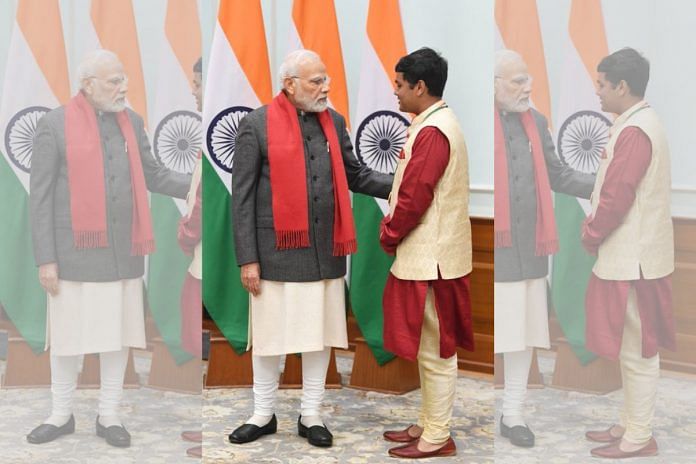Earlier this year, I was fortunate to be one of the 11 children in India to be awarded the Pradhan Mantri Rashtriya Bal Puruskar for 2023. The award is given to children under the age of 18 for doing something exceptional in their respective fields at the national and international level. I received the award in the category of innovation for my research project that quantifies and filters microplastics in drinking water.
I first heard about ‘microplastics’ in the eighth grade. A senior in my high school has presented his research work on an international forum. That inspired me to conduct my own research. Over time, my curiosity about microplastics grew. I turned to my Chemistry teacher, Sushil Kumar Pandey, who agreed to mentor me and give direction to my ideas. And that is how I began this amazing journey of innovation and learning.
As I read more, I realised how microplastics could become a huge problem in the near future. It is found in various forms, such as microbeads, microfoams, and microfibers. Large pieces of plastic also break down into microplastics by constant abrasion of waves and the action of ultraviolet rays.
The study that grabbed my attention was a global assessment by Orb Media and a researcher at the University of Minnesota School of Public Health. It stated that microplastics were found in about 83 per cent of tap water samples tested from more than a dozen countries on five continents. The results showed that an average human being could be consuming microplastics equivalent to a credit card in a week just from drinking water.
I also read about the research conducted by a group of professors based in the Netherlands, who discovered the presence of microplastics in human blood and explained how its size allows microplastic particles to pass through the cell membrane to seep into muscle or blood tissues. I also looked at the research by scientists of the Water Research Institute in Italy, highlighting how microplastics can cause serious health problems such as disease and the growth of tumours.
Apart from reading research papers and studies, I reached out to professors and experts working in similar fields.
Also Read: More than 170 trillion pieces of plastic are choking oceans worldwide, finds US institute
Sourcing materials
The turning point was when I came across a study that highlighted the interaction between microplastics and microalgae along with the use of biochemical dye in staining microplastics.
Using these studies, I designed a two-step process that would help detect and reduce the amount of microplastics in drinking water.
To develop the project, I learnt Python, web development, and 3D-printing, and also understood the lab protocols. It took me several months of daily practice to gain these skill sets.
The biggest obstacle in the development of this project was the sourcing of materials, the microalgae and the biochemical dye. The Nile Red dye is expensive and was sourced after persistent efforts. No lab supplier was ready to provide the dye to school students. Hence I had to order it from a research laboratory, SRL Chem. They verified my purpose using a certificate from the school.
The microalga R. Salina had to be imported from the University of Texas, as they have a culture collection of algae. They verified my research purpose before accepting the order. It took more than a month to receive the material due to import protocols for chemical substances.
Once I had the materials, I started building the prototype which involved tests and experiments. This was all done with the support of my teacher-mentor, school principal Amitava Ghosh and assistance from the Initiative for Research and Innovation in STEM (IRIS).
I started working on the project when I was just 12. It took two years for the work to reach its conclusion. However, a research project like this is never done, and there is always room for further development.
Also Read: This veiled jal saheli & her all-women team revived a river. Their village is now thriving
National acclaim
The project was awarded the silver medal among 1,000+ finalists at the Genius Olympiad 2020. I was also fortunate to be a finalist at Regeneron ISEF 2020, representing India at the world’s largest pre-college STEM competition.
Seeing the international achievement and validation this project had received, my school principal decided to nominate me for the Pradhan Mantri Rashtriya Bal Puruskar 2023. The award receives more than a thousand nominations from across India. I am and will always be grateful to him for nominating me, as I would have never imagined a chance at such a high level of competition.
Being recognised by the President and the Prime Minister was the best thing I could have dreamt of. Prime Minister Narendra Modi discussed the conceptualisation of the project with me and wished me luck in my future endeavours.
I want to continue with my mission of solving the microplastic crisis. However, I strongly feel that everyone must do something to deal with this problem. At a personal level, we should avoid purchasing water in plastic bottles and switch to no or minimal plastic. Government officials and impact groups need to continue keeping an eye on the use of plastics and make sure they are recycled. The rising presence of microplastics in the environment could become a huge climate crisis that the current and future generations will have to deal with.
Aditya Pratap Singh Chauhan was one of the recipients of the Pradhan Mantri Rashtriya Bal Puruskar 2023. He is currently pursuing the Integrated Program in Management from the Indian Institute of Management, Indore.
(Edited by Theres Sudeep)



